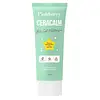What's inside
What's inside
 Key Ingredients
Key Ingredients

 Benefits
Benefits

 Concerns
Concerns

No concerns
 Ingredients Side-by-side
Ingredients Side-by-side

Water
Skin ConditioningPanthenol
Skin ConditioningButylene Glycol
HumectantPropanediol
SolventGlycerin
HumectantPhenoxyethanol
PreservativeAmmonium Acryloyldimethyltaurate/Vp Copolymer
PEG-40
HumectantTetrasodium EDTA
Allantoin
Skin ConditioningCarbomer
Emulsion StabilisingEthylhexylglycerin
Skin ConditioningAminomethyl Propanol
BufferingVitis Vinifera Leaf Extract
Skin ConditioningPorphyridium Polysaccharide
AntioxidantCaprylic/Capric Triglyceride
MaskingDeoxyphytantriyl Palmitamide Mea
Skin ConditioningHydrogenated Lecithin
EmulsifyingCeramide 3
Skin ConditioningCholesterol
EmollientHamamelis Virginiana Extract
AntiseborrhoeicHydrolyzed Collagen
EmollientWater, Panthenol, Butylene Glycol, Propanediol, Glycerin, Phenoxyethanol, Ammonium Acryloyldimethyltaurate/Vp Copolymer, PEG-40, Tetrasodium EDTA, Allantoin, Carbomer, Ethylhexylglycerin, Aminomethyl Propanol, Vitis Vinifera Leaf Extract, Porphyridium Polysaccharide, Caprylic/Capric Triglyceride, Deoxyphytantriyl Palmitamide Mea, Hydrogenated Lecithin, Ceramide 3, Cholesterol, Hamamelis Virginiana Extract, Hydrolyzed Collagen
Rice Ferment Filtrate
Skin ConditioningButylene Glycol
HumectantCaprylic/Capric Triglyceride
MaskingSqualane
Emollient1,2-Hexanediol
Skin ConditioningCetyl Alcohol
EmollientStearyl Alcohol
EmollientLactobacillus Ferment Lysate
Skin ConditioningIsopentyldiol
HumectantWater
Skin ConditioningCeramide NP
Skin ConditioningPropanediol
SolventGlycerin
HumectantBifida Ferment Lysate
Skin ConditioningStreptococcus Thermophilus Ferment
HumectantMadecassoside
AntioxidantAmmonium Acryloyldimethyltaurate/Vp Copolymer
Hydroxyethyl Acrylate/Sodium Acryloyldimethyl Taurate Copolymer
Emulsion StabilisingEthylhexylglycerin
Skin ConditioningRice Ferment Filtrate, Butylene Glycol, Caprylic/Capric Triglyceride, Squalane, 1,2-Hexanediol, Cetyl Alcohol, Stearyl Alcohol, Lactobacillus Ferment Lysate, Isopentyldiol, Water, Ceramide NP, Propanediol, Glycerin, Bifida Ferment Lysate, Streptococcus Thermophilus Ferment, Madecassoside, Ammonium Acryloyldimethyltaurate/Vp Copolymer, Hydroxyethyl Acrylate/Sodium Acryloyldimethyl Taurate Copolymer, Ethylhexylglycerin
Ingredients Explained
These ingredients are found in both products.
Ingredients higher up in an ingredient list are typically present in a larger amount.
Ammonium Acryloyldimethyltaurate/Vp Copolymer (let's call it AAVC for short) is a synthetically created polymer. It's used as a film-forming agent and used to thicken the consistency of products.
AAVC is able to increase the consistency and viscosity of products due to its large molecule size. It also prevents ingredients from separating.
Butylene Glycol (or BG) is used within cosmetic products for a few different reasons:
Overall, Butylene Glycol is a safe and well-rounded ingredient that works well with other ingredients.
Though this ingredient works well with most skin types, some people with sensitive skin may experience a reaction such as allergic rashes, closed comedones, or itchiness.
Learn more about Butylene GlycolThis ingredient is an emollient, solvent, and texture enhancer. It is considered a skin-softener by helping the skin prevent moisture loss.
It helps thicken a product's formula and makes it easier to spread by dissolving clumping compounds.
Caprylic Triglyceride is made by combining glycerin with coconut oil, forming a clear liquid.
While there is an assumption Caprylic Triglyceride can clog pores due to it being derived from coconut oil, there is no research supporting this.
Learn more about Caprylic/Capric TriglycerideEthylhexylglycerin (we can't pronounce this either) is commonly used as a preservative and skin softener. It is derived from glyceryl.
You might see Ethylhexylglycerin often paired with other preservatives such as phenoxyethanol. Ethylhexylglycerin has been found to increase the effectiveness of these other preservatives.
Glycerin is already naturally found in your skin. It helps moisturize and protect your skin.
A study from 2016 found glycerin to be more effective as a humectant than AHAs and hyaluronic acid.
As a humectant, it helps the skin stay hydrated by pulling moisture to your skin. The low molecular weight of glycerin allows it to pull moisture into the deeper layers of your skin.
Hydrated skin improves your skin barrier; Your skin barrier helps protect against irritants and bacteria.
Glycerin has also been found to have antimicrobial and antiviral properties. Due to these properties, glycerin is often used in wound and burn treatments.
In cosmetics, glycerin is usually derived from plants such as soybean or palm. However, it can also be sourced from animals, such as tallow or animal fat.
This ingredient is organic, colorless, odorless, and non-toxic.
Glycerin is the name for this ingredient in American English. British English uses Glycerol/Glycerine.
Learn more about GlycerinPropanediol is an all-star ingredient. It softens, hydrates, and smooths the skin.
It’s often used to:
Propanediol is not likely to cause sensitivity and considered safe to use. It is derived from corn or petroleum with a clear color and no scent.
Learn more about PropanediolWater. It's the most common cosmetic ingredient of all. You'll usually see it at the top of ingredient lists, meaning that it makes up the largest part of the product.
So why is it so popular? Water most often acts as a solvent - this means that it helps dissolve other ingredients into the formulation.
You'll also recognize water as that liquid we all need to stay alive. If you see this, drink a glass of water. Stay hydrated!
Learn more about Water